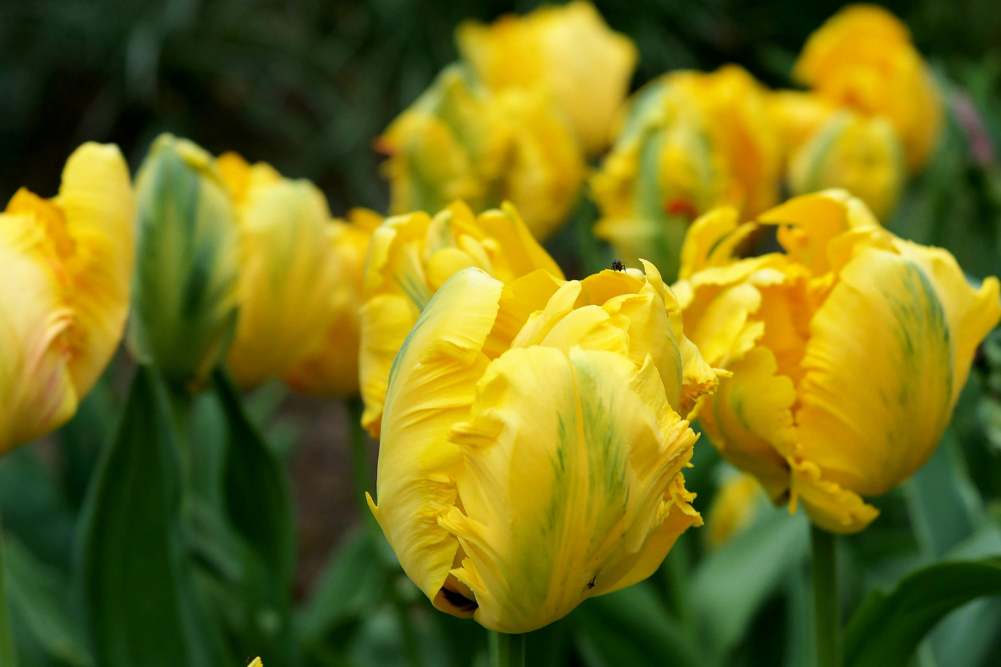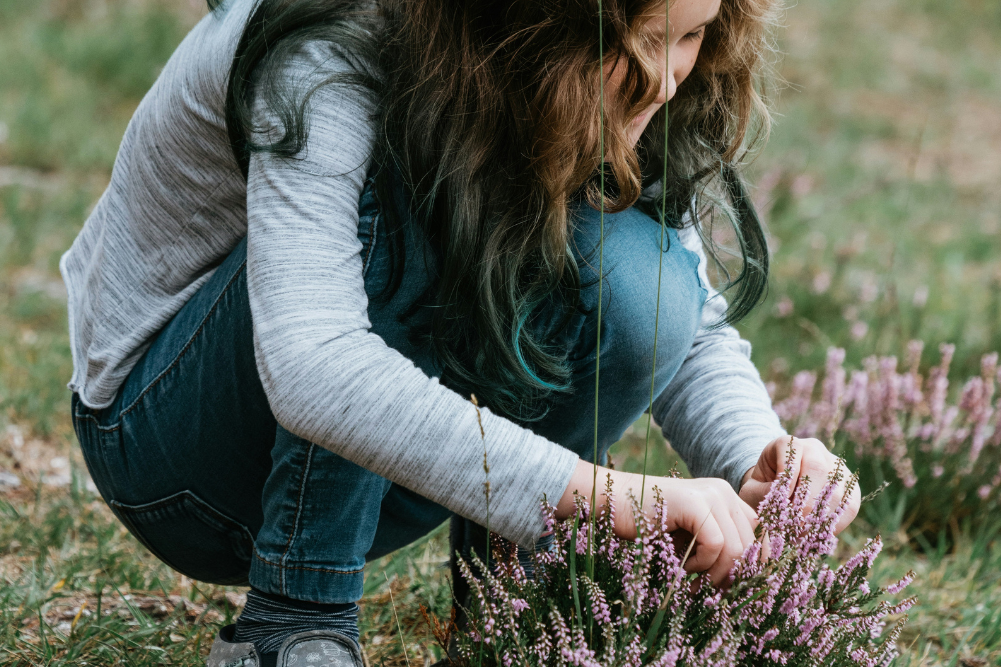Green and sustainable gardening
Organic gardening for sustainable and green living is all about providing a healthy, nurturing environment where plants thrive without chemical intervention. It’s about selecting plants suited to the climate and soil. Endemic species may be more suitable than thirsty exotics, and non-hybrid varieties of plants and seeds are often more resistant to pests and diseases. It’s about creating balance with diversified plantings, a pond or other water source, and stands of native shrubs — grevillea, hakea leptospermum and melaleuca species — in quiet corners. It’s about continually improving the health of the soil, putting back what you take out, plus a little bit more. It’s about understanding that all living things have a purpose, for by doing these things you build worm and microorganism colonies in the soil and attract lots of predatory wildlife: birds, lizards, centipedes, beetles, snakes and frogs that you welcome because they keep the problem insects under control.
Healthy soil for green and sustainable gardening
The structure of all types of soil improves with the addition of large amounts of organic matter such as compost, animal manures, green manures, wood ash from untreated sources, leaf mulch, blood and bone, urine, fish meal, shredded paper and composted lawn clippings. These naturally occurring materials facilitate root penetration, help with nitrogen fixing, make nutrients more available to plants and increase the soil’s capacity to retain water.
Large garden centres carry fresh animal manures and pelletised chicken manure, which contain the highest level of nutrients. Because birds don’t urinate, their dung is exceptionally high in nitrogen. If you are serious about going organic all the way, look for organic manures, because non-organic brands may come from farms that use antibiotics and chemical weed killers and fertilisers. Composting breaks down many contaminants, but it may take some time, depending on the heat of the compost pile. If you are prepared to take the risk, go for a drive in farming country and look for signs offering horse, sheep or cow manure for sale. Stable manure is particularly good as it usually includes straw, which collects the horse’s urine: check the classified ads for local stables offering bulk deliveries.
Because fresh manures may encourage root rot and other pathogens if applied directly to the Garden, they should always be composted first. Always cover the manure heap with soil or sawdust to prevent excessive nitrogen loss. When the manure has decomposed, spread it over the top of the garden rather than digging it in: let the worms and other soil life pull it into the depths.
Compost promotes green and sustainable living
The best compost contains a mixture of ingredients: animal manures, plant wastes (including hay or straw), kitchen scraps, shredded brown paper and newspaper, grass clippings, shredded leaves (run the lawnmower over them), feathers, untreated sawdust, weeds and washed seaweed. Leave out oils, fats, meat or animal products, pet waste (it may contain pathogens that will not be destroyed even in a hot pile), diseased or infected plants, thorny clippings (eg roses), weeds that have bloomed and gone to seed, poisonous plants such as oleander.
Position the compost bin with the open bottom in contact with ungrassed earth to allow the worms to work it and add their valuable castings. Add the materials in layers. Yarrow and comfrey can halve composting time: mix five chopped leaves of each herb to two cubic metres of compost. Lime or dolomite supplies magnesium, so add two cups per metre of compost (except if you plan to use it on acid-loving plants like azaleas). Keep the compost moist, but not wet, and loosen and turn the mixture weekly with a gardening fork. When it’s ready — three to six months in cooler weather, two to three months in hot — it should be sweet smelling, cool and dark, with a crumbly consistency.
If you don’t have room for a compost bin, you can still recycle kitchen scraps to benefit of the garden. Save vegetable and fruit peelings, coffee grounds, tealeaves and washed eggshells in a small covered container. Once a day, whiz them in a blender or food processor with sufficient water to cover. Dig a hole or trench in the garden, pour in the puree and cover with earth or manure.
Green manure crops for green and sustainable gardening
Many organic experts recommend
Fertilisers for sustainable and green gardening
Here is a wonderful liquid manure for vegetables for sustainable gardening: in a 44-gallon drum place two bucketfuls of cow, horse or chicken manure, half a bucket of comfrey leaves and several stinging nettle leaves (if you can get them). Fill the drum with water and mix everything together. Place the lid on the drum and leave for four to six weeks. You can also use a large garbage bin, adding ingredients proportionately. Apply the liquid manure (diluted one part fertiliser to three parts water) only occasionally to give plants a boost — using it too often will create unhealthy growth.
Foliar fertilising supports a sustainable garden
Foliar fertilisers supply plants with trace minerals through their leaves, a method said to be significantly more efficient at providing the plant with nutrients than soil fertilisation and thus support sustainable gardening. Plants absorb the nutrients in around four hours. Foliar fertilising also helps control mould and mildews, increases fruit set and boosts resistance to both frost and drought. Foliar-fertilise seedlings before they are planted out, again when the plants are half grown, and finally when they are flowering. An extremely effective foliar fertiliser that gives plants the trace minerals they need for health and strong growth is a combination of three parts fish emulsion to one part seaweed extract, diluted with water as recommended. Apply on a cloudy (but not rainy) day or in the late afternoon when the sun is off the plants.
Crop rotation for sustainable green gardneing
Different plants extract nutrients in different combinations from the soil; rotating the various types of plants allows the soil to rebuild while still producing. As an example: after harvesting leguminous crops such as butter beans or snow peas, which add nitrogen to the soil, you can grow tuberous crops without needing to add more fertiliser to the soil.
Crops are classified according to their characteristics and physical form:
- Tuberous: Potatoes, carrots, beetroot, parsnips, turnips, swedes
- Surface: Lettuce, bok choy, pak choy, rocket, spinach, celery, the brassicas: cabbage, cauliflower, broccoli, Brussels sprouts
- Shrubs: Tomatoes, capsicums, eggplant, beans, peas
- Grains: Corn, oats, millet, wheat
- Vines: Cucumbers, zucchini, squash, melon, pumpkin
- So following the above sequence of groupings (which is not mandatory — use a sequence that suits your climate), you could start with carrots, go on to broccoli, then tomatoes, followed by sweet corn and finally zucchini.
Weeds in your sustainable green garden
One way to get rid of a lot of weeds in a new or neglected garden, or a garden where previous weed control consisted of swiping the weed with a glyphosate wand, is to give them their head before planting a proper garden. Prepare the soil at least one month beforehand and water to encourage the seeds to sprout. When the garden is thick with young weeds, dig them out, being sure to get all the roots.
Every time you walk in the garden, pull a few weeds and you’ll keep things in order. For hard-to-extract weeds that pop up between paving stones, pour boiling water on them. Thick plantings suppress weeds, as the light cannot get through to the soil. Mulching does the same: use natural materials (black plastic sours the soil) like wads of newspapers or lucerne hay. Many regions offer local crop waste as mulch: peanut shells, sugar cane, tea tree and poppy are some examples.
Pests in your green garden
In nature, there is no such thing as perfection, so don’t stress over a few chewed leaves: holes in broccoli leaves won’t render the vegetable any less tasty or nutritious. The first line of defence with pest control is to keep a close eye on your plants, inspecting them for damage or disease every couple of days. If you notice an infestation, remember that predators always follow pests, so pick off pests by hand and wait a day or so before spraying to see if a natural predator is solving the problem. Only as a last resort should you use sprays (even the organic variety). Choose from the range that is acceptable under the Draft National Standard of Organic and Biodynamic Produce. These include:
- Vinegar
- Vegetable oil and light mineral oil such as paraffin
- Plant oils such as neem and garlic
- Pyrethrum
- Condy’s crystals
- Potassium soap
- Powered and wettable sulphur
- Plant extracts such as quassia
- Seaweed
- Sodium silicate and sodium bicarbonate
- Diatomaceous earth in non-heat treated form
- Lime and lime sulphur
Effective sprays can be easily made from many plants and herbs in your sustainable garden and items in your pantry. As an example: mustard spray kills scale, mite, aphids and thrips: combine two tablespoons mustard powder with one litre of water. Nasturtium spray applied to the foliage and fruit of fruit trees repels whitefly, woolly aphids, borers and codling moth. Gather three tightly packed cups of nasturtium leaves, and pour over one litre of boiling water. Stand until cool, strain through cheesecloth, and use the mixture within a few hours.
Interplanting and companion planting help create a pest-resistant garden: start by positioning herbs all through the garden instead of keeping them together in a separate plot. I recommend Jackie French’s Guide to Companion Planting in Australia and New Zealand, one of the best books on this complex subject. Ms French explains that companion planting works on several levels:
- One plant attracts predators that eat the pests on the companion plant
- One plant repels another’s pests
- One plant produces substances that help another plant in various ways
- The
growing habits of one plant fit in with thegrowing habits of another Ms French warns readers that most companion planting rules don’t work in Australia because they were developed in Europe and the USA.
Another excellent book is Penny Woodward’s Pest-Repellent Plants, Hyland House 1997, which contains dozens of recipes for homemade sprays.
Snails and slugs in your sustainable garden
As snails and slugs, and grasshoppers, are the source of most garden grief, here are some specific suggestions for dealing with them. Australia’s pest snails and slugs are introduced, so the range of native biologic controls is limited. Collecting snails is something the kids love to do, so delegate the job to them. However, first have a thorough garden cleanup, removing garden rubbish and old wooden boards (wear protective clothing). Seek out colonies under climbing plants, or in thick clumps of plants, in stone walls and edgings, around drains and compost heaps, inside stored pots and under loose stepping stones. Drown them in a bucket of hot soapy water as stomping on them may still leave mature eggs that will hatch.
Prepare this non-toxic bait: fill old pie dishes with beer and sink them into areas marked with telltale silver trails. Alternatively, use a strong commercial garlic spray. Lay barriers of diatomaceous earth, wood ash, dry lime, sawdust or strips of used sandpaper — remembering that these work only while dry. A more effective barrier, which works when wet or dry, is adhesive copper tape: when the snails make contact with the copper, it produces a reaction like an electric shock that repels them.
Green Grasshoppers
Head into the garden early in the morning to catch grasshoppers — either by hand or with a butterfly net — as they are less active at this time, especially after a cool night. Alternatively, trap them this way: fill some jars with a solution of nine parts water and one part molasses, and float some canola oil on the top (canola oil attracts grasshoppers and also deters mosquitoes and bees.) Bury the jars in garden. Clean and renew the bait as necessary. If the grasshoppers continue to be a problem, spray with a garlic or chilli spray. Here is a recipe for the latter that will keep for several weeks. Take care when making and using it to ensure it doesn’t touch the skin or eyes. Whiz in a blender or food processor one litre of water with two packed cups fresh hot chillies, or one cup dried. Pour into a glass container and leave to steep overnight. Strain through cheesecloth. Dilute the mixture before using it: one part chilli mix to two parts water.
Fungal control in your green garden
Healthy plants with strong cell walls are the best defence against fungi, which attack plants to feed on the sugars within the cells. If you live in a humid region, choose varieties of plants resistant to fungus. Good garden hygiene helps prevent attacks: clear away fallen leaves to remove spores and don’t compost plants or clippings from infected plants. It’s important to remove all spent crops and discarded leaves as they attract pests: rotting vegetation emits insect-drawing ethanol and ammonia. In spring, lay fresh mulch to help prevent spores moving back into the plant.
Prune plants lightly to improve air circulation, and grow susceptible vine vegetables on a trellis. Avoid overhead watering if possible: this is especially important in the evening, because the plant foliage remains damp during the night, increasing susceptibility to fungus. If it’s unavoidable, water early in the morning so the sun can quickly dry the leaves.
Dry Bordeaux powder and lime sulphur can be used to treat fungal attacks, or try this lilac spray: pour one litre of boiling water over three packed cups of lilac leaves. Stand until cool, strain through cheesecloth and use within a couple of days.
Finally, accept that it may take some time to improve soil fertility and to rebalance the ecology so that insect damage becomes minimal. Expect failures initially; just keep working towards your objective of creating your fully organic garden. You’ll be contributing to the health of the environment — and your own.
For more gardening information – from pruning standard roses to growing frangipani cuttings and everything in between visit Complete Home.







